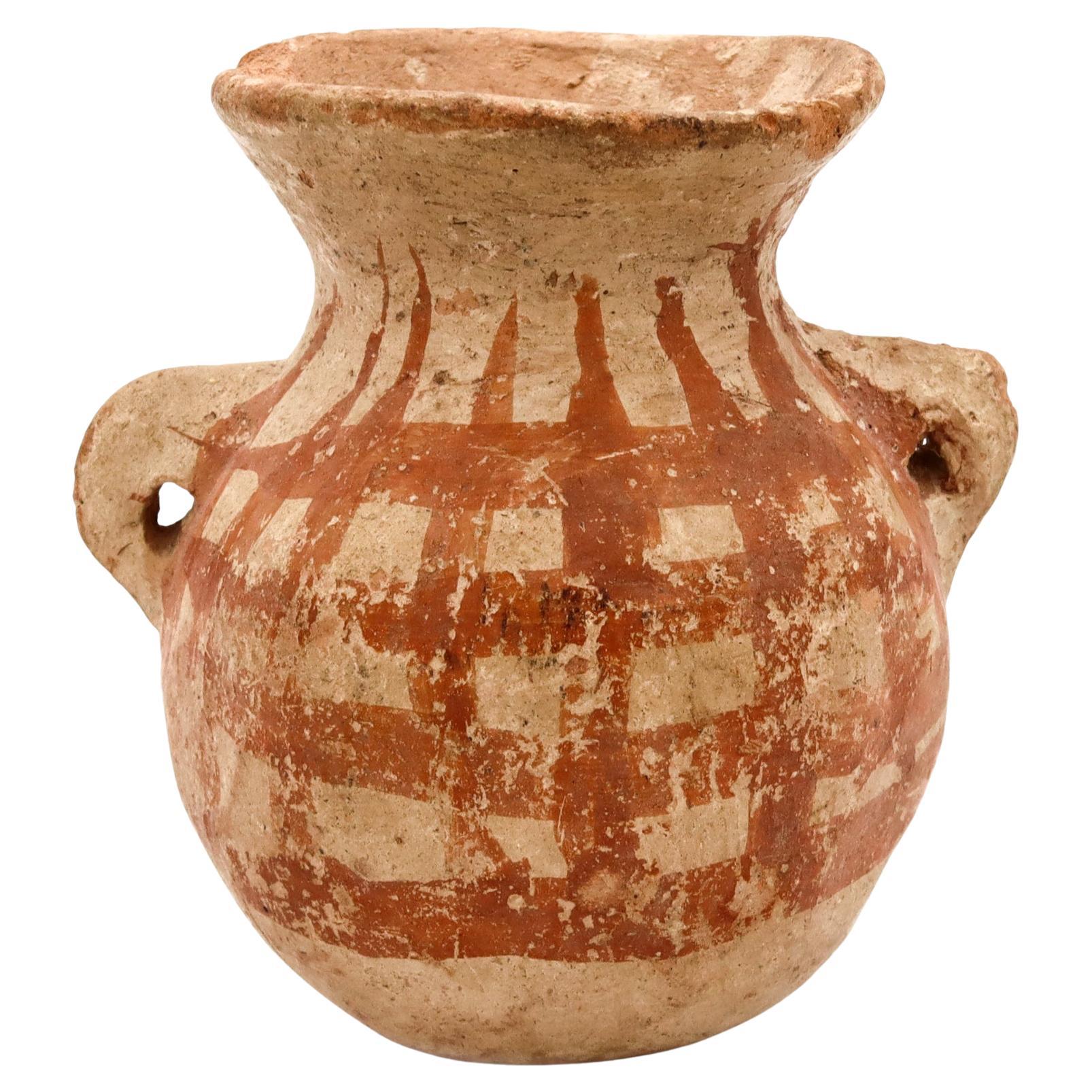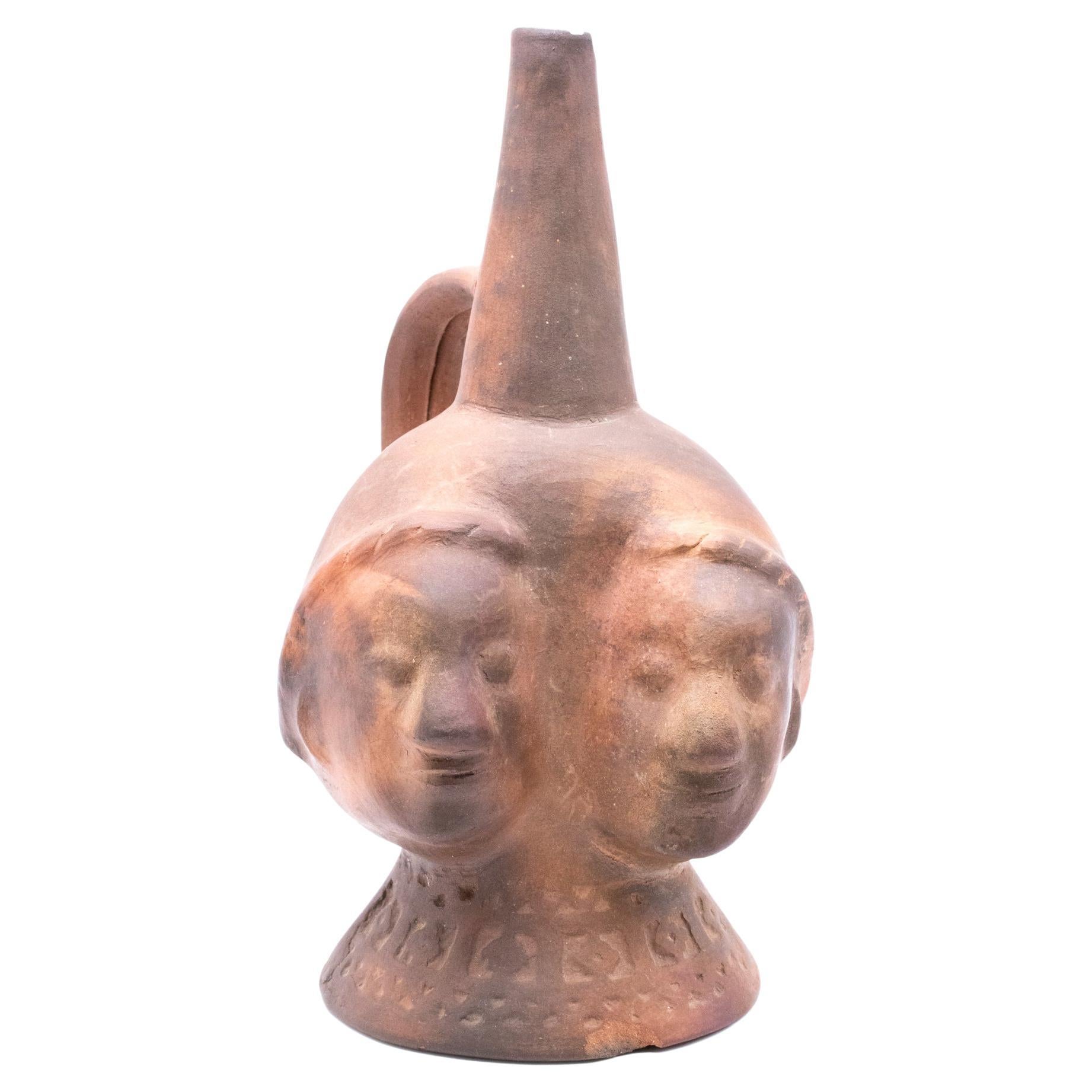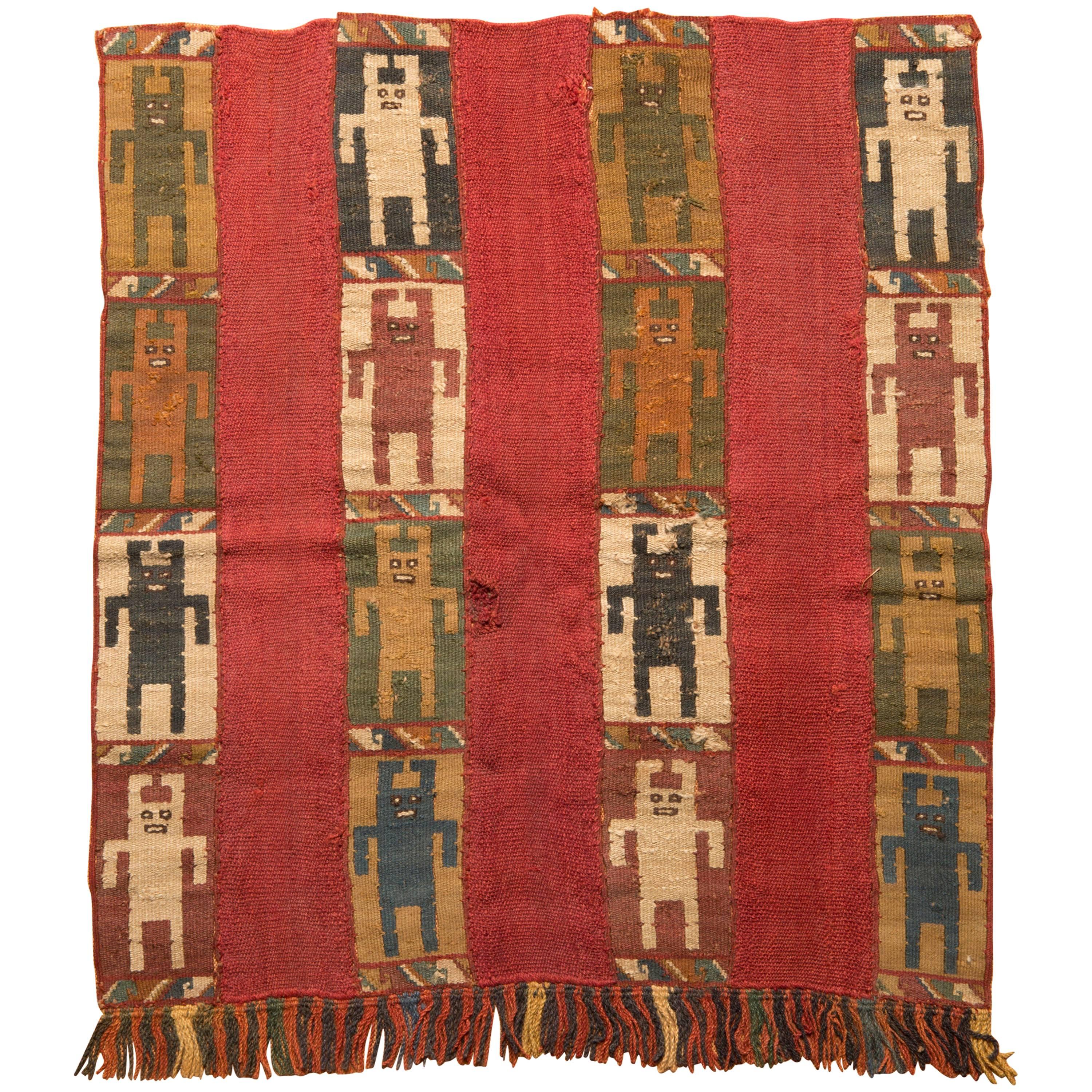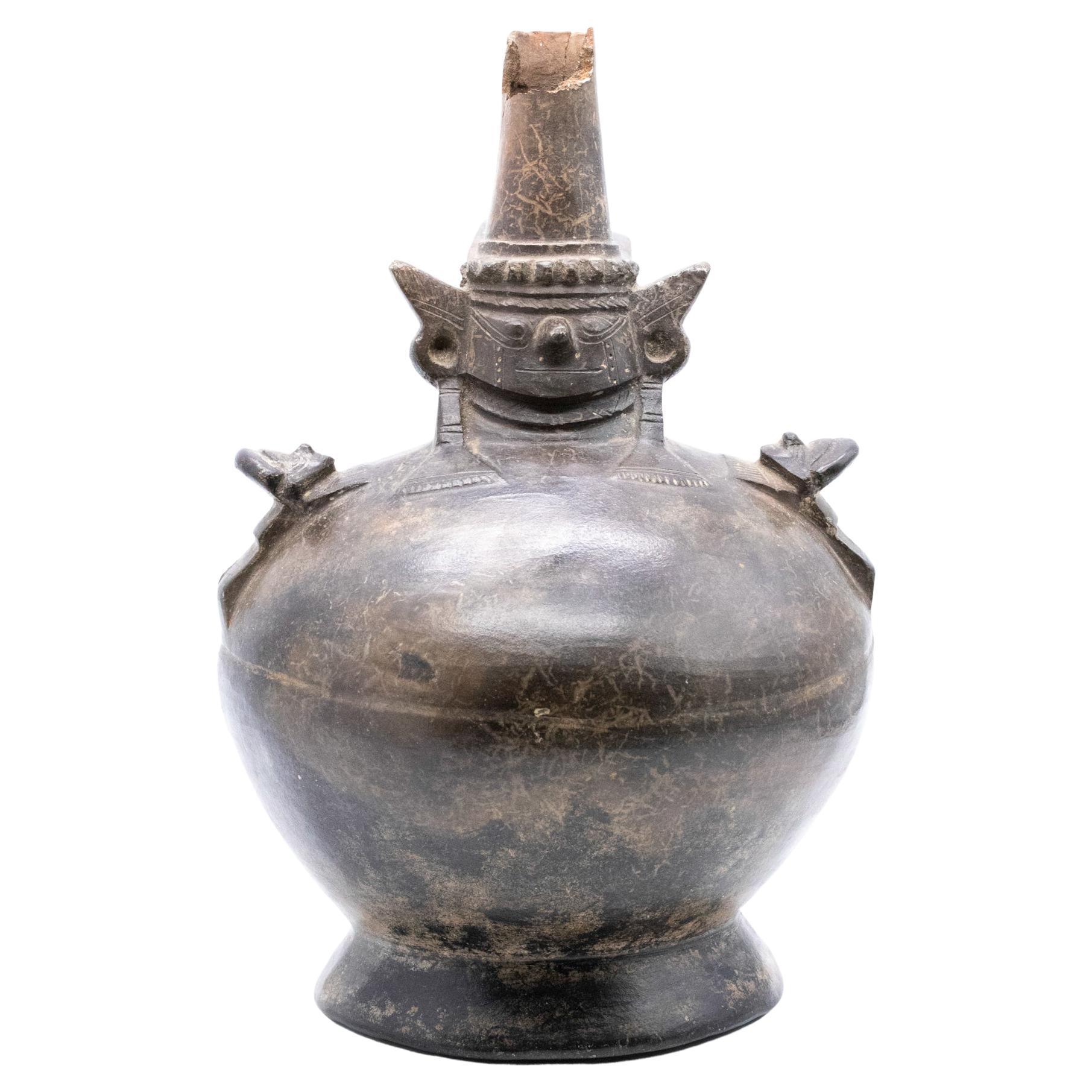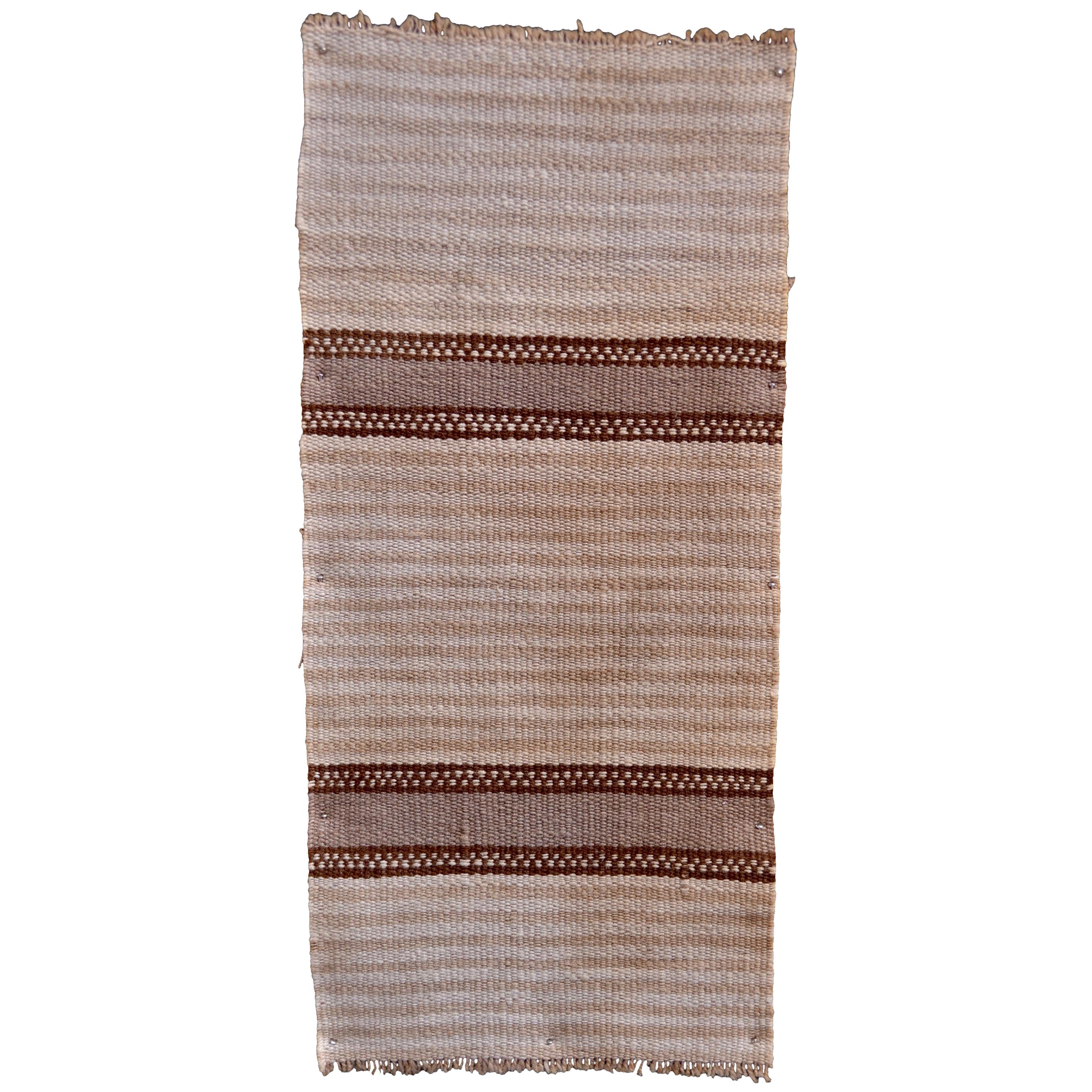Items Similar to Peru Pre Inca 100-700 Ad Moche Pre Columbian Personified Vessel in Earthenware
Want more images or videos?
Request additional images or videos from the seller
1 of 7
Peru Pre Inca 100-700 Ad Moche Pre Columbian Personified Vessel in Earthenware
About the Item
Rare pre Hispanic Moche culture, pre-Inca earthenware vessel.
A beautiful interesting piece, created in the southern Peru region around the 100-700 AD by the Moche culture. This rare early period face-neck vessel has been crafted from red earth ware pottery depicting the personified body and face of a dignitary lord wearing a head cloth with royal attires and in the left hand with a baton.
The Moche portrait vessels feature a highly individualized representation of human bodies and faces that are unique from this culture. These vessels were made in two parts molds, one for the front and the other for the back.
The Moche or Mochica civilization are the early Proto-Chimu culture that flourished in the northern coastal region of Peru with its capital near the present day Trujillo, from about the 100 to 700 AD. While this issue is the subject of some debate, many scholars contend that the Moche were not politically organized as a monolithic empire, they were likely a group of autonomous polities that shared a common culture as seen in the rich iconography and monumental architecture that survive today.
The following is textual from an investigation by Shannon Marie Trono, from the University of Miami...."About the stylistic differences in the ceramic production of “face-neck” vessels from the Middle Moche Period (400-600 CE) of the Northern and Southern Moche regions. These face-neck vessels are also referred to as effigy vessels or cántaros cara gollete in Andean ceramic classifications. Face-neck vessels take the shape of human bodies where the torso and limbs have been condensed into a large globular mass; on the neck (the spout of the vessel) appears a human face in relief. In this paper, I focus on fineware face-necks rather than utilitarian wares since the majority of the vessels in this discussion originate from monumental funerary complexes for the elite. Face-neck vessels were commonly used to holds liquids like corn beer, which was consumed in ceremonial practice".
Note: Ceramics is the most significant art form of the Moche culture, and its world of motifs is larger than that of any other ancient Peruvian culture. The Moche ceramists created both sculptural and plain paint-ornamented vessels. The most popular vessel form was the traditional stirrup spout vessel.
This piece have a measurements of 223 mm by 127 mm by 108 mm (22.3 x 12.7 x 10.8 Cm) (8.75 x 5 x 4.25 inches).
Provenance: A private collection in New York city collected in the 1964; T.K. Asian antiquities gallery, Williamsburg Virginia; a private collection in Palm Beach FL; then purchased by James & Nancy Markell, Virginia 1976; then by descent to Lauren Markland, Fort Lauderdale, FL.; acquired in Palm Beach, FL. in March 7, 2020
Note: A 1975 photographic evidence of collection can be provided.
Condition: It is in pretty good stable condition, with no missing parts, just few tiny flea bites and remains of soil.
Guarantee to be an authentic piece from the stated period and with an accurate description.
INVENTORY REF: D0000SNNV/.1111.
- Dimensions:Height: 8.75 in (22.23 cm)Width: 5 in (12.7 cm)Depth: 4.25 in (10.8 cm)
- Style:Pre-Columbian (Of the Period)
- Materials and Techniques:
- Place of Origin:
- Period:
- Date of Manufacture:100-700 AD Moche
- Condition:Wear consistent with age and use. It is in pretty good stable condition, with no missing parts, just few tiny flea bites and remains of soil.
- Seller Location:Miami, FL
- Reference Number:
About the Seller
5.0
Platinum Seller
These expertly vetted sellers are 1stDibs' most experienced sellers and are rated highest by our customers.
1stDibs seller since 2023
63 sales on 1stDibs
Typical response time: <1 hour
- ShippingRetrieving quote...Ships From: Miami, FL
- Return PolicyA return for this item may be initiated within 1 day of delivery.
More From This SellerView All
- Peru Pre-Inca 900 / 1470 AD Chimu Pre Columbian Vessel In Earthenware PotteryLocated in Miami, FLA pre-Inca Chimu culture, pre Columbian vase in earth ware. This beautiful little vessel vase, was created in the northern Peruvian region by the Chimu culture between the 900 / 1...Category
Antique 15th Century and Earlier Peruvian Pre-Columbian Antiquities
MaterialsEarthenware, Pottery
- Peru Pre-Inca 1270 AD Chimor Pre Columbian Double Face Vessel In EarthwareLocated in Miami, FLPre Hispanic earth ware vessel from the pre-Inca Chimu culture. Beautiful ancient vessel, created in northern coast of Peru around the 900 / 1470 AD. by the Chimu culture. This is...Category
Antique 15th Century and Earlier Peruvian Pre-Columbian Antiquities
MaterialsEarthenware, Pottery
- Peru Inca 1200 AD Lambayeque Pre-Columbian Blackware Ceramic Vase with WarriorLocated in Miami, FLAn Inca Peru pre-hispanic black ware huaco vessel, from Lambayeque. Beautiful piece, created under the Inca culture between the 750 / 1375 AD at the Sican...Category
Antique 15th Century and Earlier Peruvian Pre-Columbian Antiquities
MaterialsEarthenware
- China 618-907 AD Tang Dynasty Offering Vessel With 8 Lotus Petals in EarthenwareLocated in Miami, FLOffering vessel from the Chinese Tang Dynasty (618-907 AD). A beautiful "offering spiritual vessel" from the Yunnan province region in the ancient China. This was created in clay earthenware pottery during the Tang Dynasty period between the 618 and 907 AD. Featuring finely molded patterns with incised and high reliefs of geometric figures. The design consists of the bombe round-shaped jar and a lid with a conical knob, which are decorated in relief with one single layer of finely sculpted 8 lotus petals. The lid is decorated with geometric figures and the knob in the lid is plain, topped by a form known as a vase. Has a combined measures including the lid of 8.25 by 7 inches (20.95 x 17.78 Cm). Tang dynasty or Tang Empire, was an imperial dynasty of China that ruled from 618 to 907, with an interregnum between 690 and 705. It was preceded by the Sui dynasty and followed by the Five Dynasties and Tend Kingdoms period. Historians generally regard the Tang as a high point in Chinese civilization, and a the golden age of cosmopolitan culture. Tang territory, acquired through the military campaigns of its early rulers, rivaled that of the Han dynasty. The Li family founded the dynasty, seizing power during the decline and collapse of the Sui Empire and inaugurating a period of progress and stability in the first half of the dynasty's rule. The dynasty was formally interrupted during 690–705 when Empress Wu Zetian seized the throne, proclaiming the Wu Zhou dynasty...Category
Antique 15th Century and Earlier Chinese Tang Antiquities
MaterialsEarthenware, Pottery
- China 549-577 AD Northern Qi Dynasty Ancient Caparisoned Horse in EarthenwareLocated in Miami, FLExtremely rare Chinese pottery caparisoned horse from the Northern Qi region. A beautiful large sculptural piece, created in China during the Northern Qi dynasty period, between the 549 and 577 AD. This horse statue is extremely finely modeled of earthenware pottery, standing in a very elegant and majestic position striding on a trapezoidal shaped base. The animal has a gracefully arched neck to the left looking forward and its extremely well modeled. The head is adorned with a large detailed tassels of plumes and the body is embellished with a beautiful saddle and intricate harnesses. The trapping around the chest and rump is adorned with elaborated tassels and the straps are accented with multiples florets and bosses in high relief. Decorated with dotted and circles patterns. The surface is treated with applications of natural color pigments such; red, white and others. Has a measurements of 435 mm by 319 mm by 243 mm (17.10 x 12.55 x 9.55 Inches) (43.5 x 31.9 x 24.3 Cm). Northern Qi, was the successor state of the Chinese Xianbei state of Eastern Wei...Category
Antique 15th Century and Earlier Chinese Archaistic Antiquities
MaterialsEarthenware, Clay, Paint
- China 549-577 AD Northern Qi Dynasty Ancient Caparisoned Horse In EarthenwareLocated in Miami, FLExceedingly rare Chinese pottery caparisoned horse from the Northern Qi region. A beautiful sculptural piece, created in China during the Northern Qi dynasty period, between the 549 and 577 AD. This horse statue is extremely finely modeled of earthenware pottery, standing in a very elegant and majestic position striding on a trapezoidal shaped base. The animal has a gracefully arched neck to the left and its extremely well modeled. The head is adorned with a large detailed tassels of plumes and the body is embellished with a beautiful saddle and intricate harnesses. The trapping around the chest and rump is adorned with elaborated tassels and the straps are accented with multiples florets and bosses in high relief. The surface is treated with applications of natural pigments such; red, white and others. Has a measurements of 394 mm by 343 mm by 257 mm (15.53 x 13.52 x 10.15 Inches) (39.4 x 34.3 x 25.7 Cm). Northern Qi, was the successor state of the Chinese Xianbei state of Eastern Wei...Category
Antique 15th Century and Earlier Chinese Archaistic Sculptures and Carvings
MaterialsEarthenware, Pottery
You May Also Like
- Pre-Columbian Inca Mantle with 16 Figures, Peru, 1476-1534 ADLocated in San Pedro Garza Garcia, Nuevo LeonInca Mantle with 16 figures in cubist form with multi-color fringes. This pieces with a Certificat de Bien Culturel from France. For the Incas finely worked and highly decorativ...Category
Antique 15th Century and Earlier Peruvian Pre-Columbian Antiquities
MaterialsTextile
- Striped Inca Pre-Columbian Textile, Peru, circa 1400-1532 AD, Ex Ferdinand AntonLocated in San Pedro Garza Garcia, Nuevo LeonEarth tones adorn this striped pattern pre-Columbian textile. These piece is mounted on a black shadowbox frame. It is a wonder to behold antiquities such as a pre-Columbian textiles, an authentic piece of art that has been preserved for centuries and that survives generation after generation. Textiles are infinitely more delicate than wood, metal, or rock artifacts -- so the existence of these pieces after hundreds and thousands of years is exceptional. These textiles maintain their vibrant colors, natural threads, and their unique, historical designs. Provenance: This textile comes from the collection Ulrich Hoffmann, Stuttgart and former collection of the archaeologist Ferdinand Anton...Category
Antique 15th Century and Earlier Peruvian Pre-Columbian Antiquities
MaterialsTextile
- Pre-Columbian Inca Complete Uncu Textile, Peru 1300-1500 AD, Ex Guillot-MuñozLocated in San Pedro Garza Garcia, Nuevo LeonInca Complete Uncu of beautiful geometric composition with serpent form in red, purple and yellow. This beautiful poncho of a geometric composition has only some worn out sections on...Category
Antique 15th Century and Earlier Peruvian Pre-Columbian Tapestries
MaterialsTextile
- Striped Inca Pre-Columbian Textile, Peru, circa 1400-1532 AD, Ex Ferdinand AntonLocated in San Pedro Garza Garcia, Nuevo LeonEarth tones adorn this striped pattern pre-Columbian textile. It is a wonder to behold antiquities such as a pre-Columbian textiles, an authentic piece of art that has been preserved for centuries and that survives generation after generation. Textiles are infinitely more delicate than wood, metal, or rock artifacts...Category
Antique 15th Century and Earlier Peruvian Pre-Columbian Antiquities
MaterialsTextile
- Ancient Pre-Columbian Inca Chimu Silver Portrait Votive Cup Vessel Peru 1400 CELocated in Portland, ORAn important Pre-Columbian Inca/Chimu silver portrait vessel cup, Peru, 1400 CE. The indigenous people of Peru created these vessels for more than domestic purposes. Rather, they were used during life & after life at funerary ceremonies that incorporated intricate religious libations and imbibing rites. To create this piece, the ancient metalsmith hammered a piece of silver into a very thin sheet, approximately the size of the finished work. Then, the artisan used fine-grained stone anvils and hammer stones...Category
Antique 15th Century and Earlier Pre-Columbian Antiquities
MaterialsSilver
- Pre-Columbian Warrior Banner, Chimu, Peru, circa 1100-1476 ADLocated in San Pedro Garza Garcia, Nuevo LeonPre-Columbian ornamental banner with fringes composed of warriors/divinities holding figures in their hands, surrounded by geometric frets. Two-headed birds in alternating colors decorate the top and bottom of the banner. This one-of-a-kind tapestry has preserved its vibrant original colors and fibres. Professionally cleaned. Provenance: Private European Collection Textiles from elite Chimu tombs include elaborate gauzes, embroidery, painted plain weave and tapestry, and three-dimensional fibre sculptures. Among others, shades of yellow and brown, scarlet, white, lavender-blue and olive green were the colors used. Birds and a deity wearing a crescent-like headdress have been the most popular decorative motifs. Many Chimu textiles...Category
Antique 15th Century and Earlier Peruvian Pre-Columbian Antiquities
Recently Viewed
View AllMore Ways To Browse
Pre Used Furniture
Used Furniture In Miami
Just Folk
Columbian Art
Used Furniture Fl
Peruvian Collection
Red Earthenware
James I Furniture
Spout Vessel
Antique Elite Furniture
Royal Palm
Antique Peruvian
Antique Folk Portrait
Antique Folk Art Portrait
Antique Peruvian Furniture
Antique Liquid
Coastal Motif
Antique Furniture In Virginia
